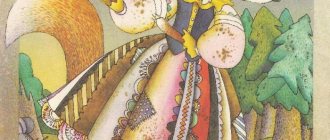Literary reading project for grade 3 “Russian folk tales”
art therapy specialist
Description of the presentation by individual slides:
Project on literary reading “Russian folk tales” Prepared by: 3rd grade student of the MKOU Nagaevskaya Secondary School Kamaletdinov Samir supervisor: Andreeva L.V. 2018-2019 academic year G.
There are many fairy tales in the world, sad and funny. We can't live without light, We can't live without them. May the heroes of fairy tales Give us warmth, May Good triumph over evil forever!
Goal: To get acquainted with Russian folk tales, to instill love and interest in Russian folk art. Objectives: 1. to develop knowledge about Russian folk tales. 2. cultivate interest in Russian folk art. 3. instill a love for books.
Hypothesis: answer the question of what the fairy tale teaches. Research methods: 1. Reading and studying fiction; 2. Watching cartoons and fairy tales; 3. Drawing fairy tale heroes.
History: The creation of fairy tales has an ancient history. Fairy tales appeared in such ancient times that it is very difficult to accurately determine the time of their birth. We also know little about the authors. Most likely, the fairy tales were composed by the same peasants and shepherds who often acted as the main characters of the story. They passed on fairy tales from mouth to mouth, from generation to generation, changing and adding new details along the way. Tales were told by adults and - contrary to our understanding - not only to children, but also to adults. Fairy tales taught us how to get out of difficult situations, overcome trials with honor, conquer fear - and every fairy tale ended with a happy ending. Some scientists believe that the origins of fairy tales lie in primitive rituals. The rituals themselves were forgotten, but the stories were preserved as treasures of useful and instructive knowledge.
A fairy tale is a special type of oral folk art. They came to us from the distant past. This is how our ancestors expressed their attitude to reality, to the world around them, and tried to explain the main laws of life. Reality changed, fairy tales changed, but the main meaning always remained: unbridled faith in goodness, in the strength of spirit, in love. Conventionally, Russian folk tales are divided into three groups: everyday tales, tales about animals and fairy tales. And each has its own characteristics. Households, for example, teach that happiness is not measured in money. And real happiness is family, work, love. It is no coincidence that a poor peasant is always smarter and happier than a rich master.
There are many sad and funny fairy tales in the world, we can’t live without light, we can’t live without them. May the heroes of fairy tales give us warmth, may good triumph over evil forever!
Types of fairy tales about animals; magical; social and household.
Source
art therapy specialist
Description of the presentation by individual slides:
Author of the project: Melnikov Egor, student of class 3A of MBOU "Romodanovskaya Secondary School No. 1" Teacher: Purtsakina L.I. The theme of the project is “Russian folk tales”
Let's check how you know fairy tales. Let's solve the riddles. But the road is long, And the basket is not easy, I would like to sit on a stump, I would like to eat a pie.
- Oh, Petya, simplicity, I messed up a little: I didn’t listen to the cat, I looked out the window.
The beautiful maiden is sad: She doesn’t like spring, It’s hard for her in the sun, The poor thing is shedding tears
There is neither a river nor a pond. Where can I drink water? Very tasty water in the hoof hole!
The little goats opened the door, and they all disappeared somewhere!
- Let’s remember what a saying is? Name some examples. 1. In a certain kingdom, in a certain state... 2. She lived in a distant kingdom, In a distant state. The girl is beautiful, with a long braid. She sat by the window and told fairy tales. The tales are old, not short, not long. 3. Once upon a time there lived an old man and an old woman...
-In fairy tales there are magical objects. Let’s remember them by taking part in the quiz “Guess which fairy tale the object is from”
Thank you for your attention
Material number: DB-023673
Didn't find what you were looking for?
You might be interested in these courses:
Project “Russian folk tales”
Natalia Kunina
Project “Russian folk tales”
Project . " Russian folk tales "
Prepared by the project : teachers of MBDOU kindergarten No. 21 of the combined type Kunina N.V., Gordeeva N.Yu. of the middle group “Fish”
.
Project type :
• social, cognitive-creative, gaming;
• medium-term;
• group.
Project implementation period : 2 weeks (from 05/03/2018 to 05/17/2018)
.
Project participants :
• Teachers, group educators;
• Children of the middle group (children age 4-5 years)
;
• Parents.
Relevance of the project .
“Reading during childhood is primarily the education of the heart, the touch of human nobility to the innermost corners of a child’s soul.”
V. Sukhomlinsky
Many centuries ago, when there was no written language yet, oral folk art , fulfilling the same role that literature later played. People have created wonderful fairy tales for children . Works of folk art have not lost their impact on children today. Oral works reflected the deep moral ideas, dreams and beliefs of the people . The fairy tale speaks simply and convincingly about the victory of good over evil, truth over lies, and the triumph of justice. The positive hero of a fairy tale always wins .
A fairy tale is close to a child’s worldview, because he has an emotional and sensory perception of the world.
Thanks to a fairy tale, a child learns about the world not only with his mind, but also with his heart. And he not only learns, but also expresses his own attitude towards good and evil. Even children of older groups believe in fairy tales , which means that it is easier to teach and educate through it. Preschoolers learn to analyze and evaluate the behavior of heroes, develop the ability to feel and understand others, increase self-esteem, self-confidence, desire to help, sympathize with others, and most importantly, develop comprehensively.
The goal of the project : to introduce children to Russian folk tales , to create conditions for the spiritual and moral development of the child.
Project objectives :
Tasks for children:
1. Arouse interest and desire to read and listen to Russian folk tales .
2. Teach children to independently determine the main characters and the goals of their activities.
3. Learn to reason about the results of the interaction of heroes, to see the rules of life.
4. Develop children's cognitive activity, creativity, and communication skills.
5. Improve preschoolers’ methods of non-situational and personal communication.
Tasks for teachers:
1. To develop children’s knowledge about Russian folk tales .
2. Cultivate a love for fairy tales , folk art , and artistic expression.
3. Teach children to evaluate the actions of heroes.
4. Develop speech, activate vocabulary.
5. Develop creativity, fantasy, imagination.
6. Promote the development of joint creativity between parents and children.
7. To arouse parents’ interest in life in a preschool educational institution and the desire to participate in it.
Tasks for parents:
1. Participate together with the children in solving the problems of the project .
2. Develop the emotional sphere of preschoolers.
3. Develop children's creative abilities.
4. Improve communication skills with children.
5. Help and participation in the implementation of the project and the life of the group.
Products of project activities : children's works on the theme of the project “ Russian folk tales ”
: exhibition of children's drawings, modeling:
“Kolobok”
, drawing:
“Our
fairy tales ” .
Final event: Dramatization games based on fairy tales “Turnip”
,
"Teremok"
.
Collective work “Favorite
Fairy Tale ” .
Expected results.
In the process of interaction between teacher – children – parents in the implementation of the project :
Children:
1. Children will get acquainted with Russian folk tales ;
2. Children will increase their interest in telling fairy tales and looking at illustrations;
3. Through imitation of the image of fairy tale , they will learn to distinguish between good and evil; characterize actions, behavior; express emotions and understand the feelings of others.
4. The proportion of children with developed speech will increase and their vocabulary will increase.
Parents:
1. Joint activities will promote parent-child relationships.
2. The number of parents participating in joint activities will increase.
Teachers:
1. Compiling a card index with speech material (proverbs, sayings, riddles about fairy tales , fairy-tale characters ).
2. Production of joint creative works with children and parents.
3. Development of methodological recommendations for educators and parents.
4. Project .
PROJECT IMPLEMENTATION STAGES
I.Preparatory stage:
Determining the theme of the project .
Formulation of goals and objectives.
Selection of fiction, visual material (illustrations, paintings, photographs)
.
Drawing up a long-term plan for the implementation of the main stage of the project . Development of outline plans for organized educational activities.
Enrichment of the development environment.
Preparation of visual material for productive activities, didactic games, role-playing games.
Drawing up a recommended list of works of art for parents to read, watch, and discuss together.
II. The main stage of the project :
Contents of the teacher’s activities:
Change the subject-development environment in the group in accordance with the project ;
Select exhibits to create a mini-museum of fairy tales ;
Organize an exhibition of crafts and drawings “Battle of Fairy Tales ”
by teachers, children and their parents;
Select Russian folk tales and illustrations for them ;
Reading Russian folk tales and then watching cartoons based on them;
Choose board games based on fairy tales ;
Choose coloring pages based on Russian folk tales ;
Find out from children and parents what books they read at home, whether there are fairy tales .
Ask parents and their children to take part in making crafts and drawings for the decoration of the exhibition of decorative and applied arts “Look of Fairy Tales ”
.
Contents of parents' activities:
Meaningful time spent with the child, desire to take part in joint activities, common interests;
Active participation of parents in the life of the kindergarten and group;
Increasing the level of awareness of parents about the activities of preschool educational institutions.
System of activities for children.
Educational and practical part.
Morning circle “Start of the day”
:
Conversations: Introduction to the history of fairy tales : why a fairy tale is called a fairy tale ; different types of fairy tales ; fairy tales and tales about animals ; characters of Russian folk tales - what they are like ; folk tales and author's tales ; fairy tales teach ; conversation about the rules of safe behavior at home and on the street (using the plot of the fairy tales “Geese and Swans”
,
“Kolobok”
,
“Masha and the Bear”
,
“The Wolf and the Seven Little Goats”
);
watching cartoons based on the fairy tales “Geese and Swans”
,
“Girl and the Bear”
,
“Bubble, Straw and Bast Shot”
,
“Cat, Rooster and Fox”
,
“Teremok”
, etc.
Finger games: “Little Mice”
,
“Friendship”
,
“Winter Walk”
,
“Building a House”
,
“Wolf and Squirrel”,
etc.;
Outdoor games: “Baba Yaga”
(round dance,
“Baba Yaga”
) teaser,
“Catch the Kolobok”
,
“Geese and the Gray Wolf”
,
“Soap Bubbles”
,
“Blow Up, Bubble”
,
“Cat and Mouse”
,
“The Fox and the Hares”
,
“Merman”
,
“ Grandma Malanya”
,
“The Wolf and the Seven Little Goats”
,
“Geese and Swans”
,
“Cat and Mouse”
,
“Crested Hen”
,
“Golden Gate”
.
Literary Center:
Examination of illustrations of Russian folk tales , reading and telling Russian folk tales ; conversation on a fairy tale , watching cartoons, discussion of Russian folk tales ": "The Cockerel is the Golden Comb"
,
“Geese-swans”
,
“Sister Alyonushka and brother Ivanushka”
,
“At the command of the pike”
,
“Morozko”
,
“Snow Maiden”
,
“The Three Little Pigs”
,
“Zayushkina’s Hut”
,
Ryaba the Hen”
,
“Kolobok”
,
“Turnip” "
,
"The Frog Princess"
,
"Winter Hut of Animals"
,
"Snow Maiden and the Fox"
,
"Masha and the Bear"
,
"How a Goat Built a Hut"
,
"Cat, Rooster and Fox"
,
"Teremok"
,
"Fox and Hare"
,
" Fox and Geese"
,
"Fox and Goat"
,
"Fox and Crane"
,
"Zhikharka"
,
"Tar Goby"
.
Conducting board-printed, didactic, word games.
Telling a fairy tale using illustrations.
A story about your favorite fairy-tale hero based on the drawings in the book “Our Favorite Fairy Tales ”
.
Learning monologues and proverbs from fairy tales .
Cut pictures “Name the fairy tale ”
.
Art Center:
Modeling: “Kolobok”
.
Drawing: “Bubble, straw and bast shoe”
,
“Hen Ryaba”
,
“Fox and Wolf”
,
“Teremok”
,
“Cat Rooster and Fox”
,
“Wolf and Seven Little Goats”
,
“Kolobok”
.
Application: “The hut is bast and ice”
, collective applications based on
the fairy tales “The Fox and the Crane”
,
“Kolobok”
,
“The Cat Rooster and the Fox”
,
“The Fox and the Crane”
.
Construction: "Teremok"
,
"Zayushkina's hut"
.
Natural Science Center:
Conducting an experiment: “Drowning - not drowning”
(based on
the fairy tale “Bubble, Straw and Bast Shot”
).
Comparison of fairy tales "Teremok"
,
"Mitten"
and
"Jug"
.
“Book Hospital”
(book repair)
.
Center for Mathematics and Manipulative Games.
Didactic games: “My favorite fairy tales ”
, Lotto
“Teremok”
,
fairy tale is this item
from ” ,
“Name
tale ” ,
“Guess
the fairy-tale hero ” ,
“Guess
the fairy tale from the hero’s song ” ,
“Which
fairy tales are mixed up ” .
Laying out images of fairy-tale characters from geometric shapes and counting sticks.
Puzzles "Kolobok"
,
“Turnip”
,
“The Wolf and the Seven Little Goats”
.
Center for dramatization and role-playing games:
Dramatization games based on works: “Turnip”
,
“Kolobok”
,
“Teremok”
.
Role-playing game “In the theater”
.
Game "Transformation"
.
fairy tales together with the teacher : “Kolobok”
,
"Turnip"
,
"Teremok"
.
Playing out the plots of fairy tales : “The Wolf and the Fox”
,
“Cockerel - Golden Comb”
,
“Fox with a rolling pin”
.
Construction and Design Center:
Construction from a large builder "Zayushkina hut"
.
Construction using LEGO
–
"Teremok"
.
III. The final stage.
Summing up the results of project activities .
CONCLUSIONS.
The children were interested and close to the theme of the project , so they gladly took part in all the events: they learned to listen to fairy tales performed by the teacher; enjoy looking at illustrations in books. In independent play activities, familiar fairy tales are played out with the help of toys and various types of theater; Some students come up with new, their own fairy tales . The children have become friendlier; come to each other's aid more often.
Parents supported the teachers, took an active part in filling the developmental environment in the group, and showed initiative by reading more and more fairy tales ; took part in a discussion of issues about children's reading.
Thus, the work done during the project gave a positive result not only in the cognitive, speech, but also in the social development of children; and also contributed to the emergence of interest and desire among parents to take part in “ Russian Folk Tales ” project
– brought the children, parents and teachers of the group closer together.
List of used literature
1. Antipina E. A. Theatrical activities in kindergarten. – M., 2003.
2. Vasilyeva M. A. Education and training program in kindergarten - M., Mozaika-Sintez, 2009. ;
3. Veraksa N. E. Exemplary general developmental program for preschool education “From birth to school”
edited by N. E. Veraksa. Publishing house Mosaic - Synthesis Moscow, 2014. ;
4. Lykova I. A. Visual activities in kindergarten. – M., Sfera, 2007. ;
5. Kochkina N. A. Project in preschool education: Methodological manual. – M., Mozaika-Sintez, 2012. ;
6. Makhaneva M.D. Theatrical classes in kindergarten: A manual for preschool workers. – M., Sfera shopping
, 2001 ;
7. Novikovskaya O. A. “Lessons for lessons on fairy tales with children 4-5 years old ”
.
– St. Petersburg, “Parity”
2007
8. Sorokina N. F. Playing puppet theater: Program “Theater-creativity-children”
. – M., ARKTI, 2010.






